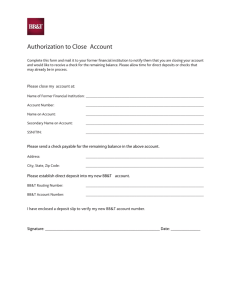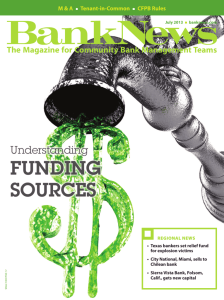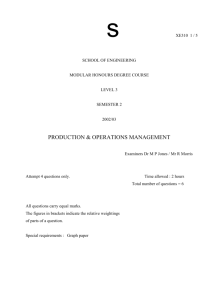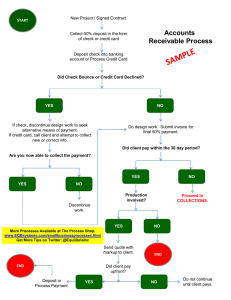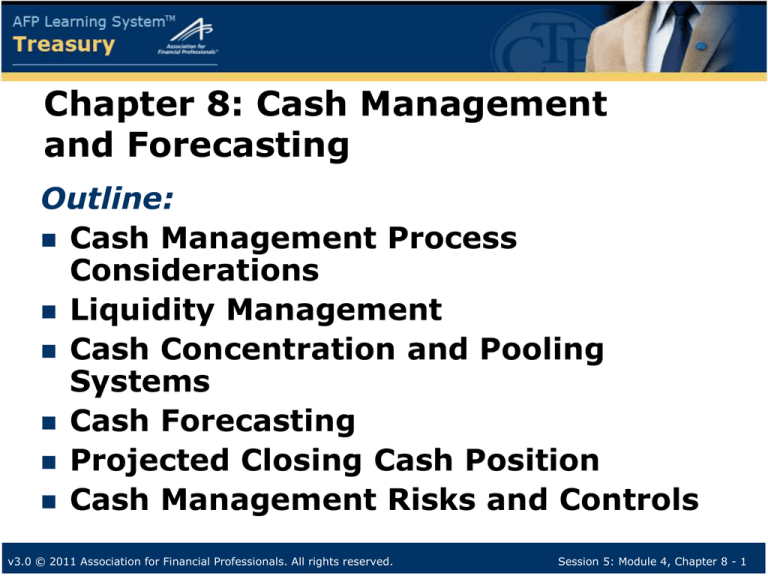
Chapter 8: Cash Management
and Forecasting
Outline:
Cash Management Process
Considerations
Liquidity Management
Cash Concentration and Pooling
Systems
Cash Forecasting
Projected Closing Cash Position
Cash Management Risks and Controls
v3.0 © 2011 Association for Financial Professionals. All rights reserved.
Session 5: Module 4, Chapter 8 - 1
Discussion Question
Which of the following is true of liquidity
management?
a) Inflows and outflows are generally well
synchronized.
b) Most large organizations will use the same
accounts for collection and disbursement of
funds.
c) The primary objective of liquidity
management is to meet daily obligations
without incurring the opportunity costs
that arise from excess or insufficient cash.
Answer: c
v3.0 © 2011 Association for Financial Professionals. All rights reserved.
Session 5: Module 4, Chapter 8 - 2
Cash Flow Diagram With
Investing and Borrowing
Short-term
investments
$
Collections
(cash inflows)
$
Concentrated
cash position
$
Disbursements
(cash outflows)
$
Short-term
borrowing
v3.0 © 2011 Association for Financial Professionals. All rights reserved.
Session 5: Module 4, Chapter 8 - 3
Why Liquidity Is Needed
Transaction
requirements
Regulatory or
covenant
requirements
Precautionary
requirements
Opportunistic
requirements
v3.0 © 2011 Association for Financial Professionals. All rights reserved.
Session 5: Module 4, Chapter 8 - 4
Proper Level of Liquidity
Insufficient
liquidity
Maintain
adequate,
but not
excessive,
liquidity.
Excess
liquidity
Time
needed to
secure
credit
Losing
interest
earnings
Credit
availability
Paying more
interest
than needed
v3.0 © 2011 Association for Financial Professionals. All rights reserved.
Session 5: Module 4, Chapter 8 - 5
Discussion Question
What is the purpose of a stress test of a shortterm liquidity forecast, and how is one
performed?
Answer:
The purpose is to forecast whether the
firm has enough cost-effective remaining
debt capacity to survive a serious, adverse
event or multiple adverse events.
The exercise assumes an adverse change
to one or more of the firm’s funding
sources, core business operations and
projects, which could in turn affect credit
ratings, defaults on covenants, etc.
v3.0 © 2011 Association for Financial Professionals. All rights reserved.
Session 5: Module 4, Chapter 8 - 6
Using Short-Term Investments for
Liquidity Management
Precautionary and
opportunistic
requirements
Earmarked funds
Temporary surplus
funds
Ongoing operations
Asset sales
Securities issuance
Seasonal performance
Short- vs. long-term
investments
Price risk
Yield pick-up
v3.0 © 2011 Association for Financial Professionals. All rights reserved.
Session 5: Module 4, Chapter 8 - 7
Discussion Question
What is the primary objective of short-term
investments? What is the trade-off a treasurer
must make in choosing among alternative
short-term investments?
Answer:
Preservation of principal is the primary
objective in selecting among
alternative short-term investments.
The trade-off is risk vs. return; return is
secondary.
v3.0 © 2011 Association for Financial Professionals. All rights reserved.
Session 5: Module 4, Chapter 8 - 8
Using Short-Term Financing for
Liquidity Management
Spontaneous financing
such as trade credit
Sources
of shortterm funds
Borrowing arrangements
or security issuance
v3.0 © 2011 Association for Financial Professionals. All rights reserved.
Sale or factoring
of A/R
Session 5: Module 4, Chapter 8 - 9
Discussion Question
What are three steps that should be taken to
properly manage short-term financing for an
organization?
Answer:
1. Careful planning of current and future
credit needs
2. Determining the short-term financing
objectives
3. Setting the overall strategic objectives
relative to the organization’s general
financing needs
v3.0 © 2011 Association for Financial Professionals. All rights reserved.
Session 5: Module 4, Chapter 8 - 10
Discussion Question
What is the objective of short-term financing?
Answer:
To ensure adequate credit availability
at minimum cost and risk and with
maximum flexibility
v3.0 © 2011 Association for Financial Professionals. All rights reserved.
Session 5: Module 4, Chapter 8 - 11
Ratios Used by Lenders to
Establish Covenants
Liquidity
Current ratio
Quick ratio
Cash flow to total
debt ratio
Indebtedness
Total liabilities to
total assets
Long-term debt to
capital
Debt to tangible net
worth
v3.0 © 2011 Association for Financial Professionals. All rights reserved.
Coverage
Times interest
earned
Fixed-charge
coverage
Performance
Cash conversion
efficiency
Return on sales
Return on total
assets
Return on common
equity
Session 5: Module 4, Chapter 8 - 12
Discussion Question
What is a MAC clause?
Answer:
A material adverse change (MAC) clause is
a common provision creditors include in
agreements. Also referred to as a
discretionary clause, a MAC clause lets a
lender refuse funding or declare a
borrower to be in default even if all
agreements are in full compliance if the
lender believes a MAC has occurred in the
borrower’s condition.
v3.0 © 2011 Association for Financial Professionals. All rights reserved.
Session 5: Module 4, Chapter 8 - 13
Short-Term Financing:
Strategic Objectives
Strategic plan
determines the
need for and use
of short-term
funds.
Management must
determine and plan for:
Level of debt
Mix of debt among
short-, intermediateand long-term sources
Mix of debt and equity
v3.0 © 2011 Association for Financial Professionals. All rights reserved.
Session 5: Module 4, Chapter 8 - 14
Global Concentration of Funds
Physical concentration
of funds; referred to as
“sweeping” outside U.S.
Notional pooling:
Company and all its
subsidiaries must
maintain accounts at the
same bank.
Positive and negative
balances are aggregated
each day to calculate
interest earned or due;
funds are not actually
transferred but merely
totaled.
v3.0 © 2011 Association for Financial Professionals. All rights reserved.
Physical pooling:
Most pooling is currently
single-currency/one
country.
Must be justified by a
careful cost/benefit
analysis.
Session 5: Module 4, Chapter 8 - 15
Discussion Question
What is an approach that combines sweeping
and pooling, when is it used, and how does it
function?
Answer: Bank overlay structure
Used when primary bank has branches in several
countries that don’t provide full domestic
banking in all countries.
Local bank is used as needed for domestic
transactions and to sweep surplus funds
to primary bank.
Primary bank (overlay bank) notionally pools
balances on overlay accounts, providing a
multi-country solution.
v3.0 © 2011 Association for Financial Professionals. All rights reserved.
Session 5: Module 4, Chapter 8 - 16
Objectives of a Cash Concentration
System
Major objectives:
Efficiently move
funds from deposit
banks to
concentration bank
Minimize excess
balances
Concentration enables:
Investing a larger
amount of funds,
potentially increasing
interest income
Paying down debt faster,
potentially reducing
interest expense
Taking advantage of
discount terms,
potentially reducing
COGS or operating
expenses
v3.0 © 2011 Association for Financial Professionals. All rights reserved.
Session 5: Module 4, Chapter 8 - 17
Discussion Question
A retail organization’s over-the-counter/field
deposit systems receive cash and/or checks drawn
on local banks at each point of sale (POS). Which
of the following provides cash/coin pickup/
delivery and immediate fund availability?
a) Having a depository institution near each field
location
b) Virtual vault services
c) Remote deposit capture (RDC)
Answer: b
v3.0 © 2011 Association for Financial Professionals. All rights reserved.
Session 5: Module 4, Chapter 8 - 18
Retailers can
get all check
deposits in one
centralized
account.
Banks may
offer improved
availability,
reducing
availability
float.
Banks produce
IRD as needed.
v3.0 © 2011 Association for Financial Professionals. All rights reserved.
Federal Reserve
Reduce
processing
float by
immediately
transmitting
for deposit.
Depository Bank
Scan and Image
Remote Deposit Capture (RDC)
Clear and
settle
electronically
through Fed or
other image
exchange
network.
Session 5: Module 4, Chapter 8 - 19
Cash Concentration System
Configuration
Considerations:
Size and geographic
distribution
Transfer alternatives
Branch footprint of
banks
EDTs and wire
transfers are most
frequent.
Field offices, field
banks,
headquarters or
concentration banks
can originate EDTs.
v3.0 © 2011 Association for Financial Professionals. All rights reserved.
Most large retail
chains transmit
information from
POS terminals to
headquarters.
Wires are an
alternative to ACH
to expedite funds
transfers.
Establish value of
funds acceleration.
Drawdown wire.
Session 5: Module 4, Chapter 8 - 20
Break-Even Wire Transfer Amount
Total ACH costs = $1.00
Total wire transfer costs = $10.00
Opportunity cost of funds = 3.5%
Minimum Transfer =
=
Wire Cost ACH Cost
Opportunity Cost
Days
Accelerated
365
Days
$10.00 $1.00
0.035
1 Day 365 Days
= $93,857
v3.0 © 2011 Association for Financial Professionals. All rights reserved.
Session 5: Module 4, Chapter 8 - 21
Bank Services that Facilitate Deposit
or Automatic Concentration
Both
require
using
multiple
branches
of single
bank.
Zero balance
account
(ZBA)
• Separate units deposit in distinct
depository accounts
• Balances transferred automatically at
end of day to master concentration
account (balance is zero)
Deposit
reconciliation
• Deposits from many locations credited
to one corporate bank account
• Auxiliary on-us field carries unique
identifier for each company location
for location-specific deposit reports
v3.0 © 2011 Association for Financial Professionals. All rights reserved.
Session 5: Module 4, Chapter 8 - 22
Excess Balances
Average collected balance is greater than
bank compensation needs or chosen
target.
Causes
Deposit reporting delays by field units
Clearing delays of one day when using ACH for
cash concentration
Transfer initiation delays if concentration
entries are submitted to the originating bank
late or contain reporting errors
Receipts posted or received subsequent to
investment cutoff times
v3.0 © 2011 Association for Financial Professionals. All rights reserved.
Session 5: Module 4, Chapter 8 - 23
Discussion Question
What bank charges are involved in a
concentration system, and what types of
banks charge fees?
Answer:
Deposit and concentration banks may assess
fees for each deposit, deposited items,
inbound and outbound wires, ACH
clearings, deposit reports, overdrafts,
negative collected balances, and account
maintenance.
v3.0 © 2011 Association for Financial Professionals. All rights reserved.
Session 5: Module 4, Chapter 8 - 24
Discussion Question
What administrative costs are typically
involved in concentration systems?
Answer:
Managing deposit reporting—receiving and
monitoring daily reports from local managers and
concentration banks
Scheduling cash transfers—deciding when
and what amounts to transfer
Preparing debit files
Reconciling deposit reports
Monitoring transfers to prevent internal
fraud
v3.0 © 2011 Association for Financial Professionals. All rights reserved.
Session 5: Module 4, Chapter 8 - 25
Reducing Concentration System
Costs
Enhance concentration system efficiency.
Improve transfer schedule timing.
Reduce excess balances.
Anticipate availability.
Anticipate deposits.
Use faster transfer mechanism.
Reduce transfer costs.
Use less expensive transfer mechanisms.
Transfer funds less frequently.
Threshold and target concentration.
v3.0 © 2011 Association for Financial Professionals. All rights reserved.
Session 5: Module 4, Chapter 8 - 26
Objectives of Cash Forecasting
Liquidity management
Schedule investment
decisions.
Anticipate borrowing
requirements.
Financial control
Meeting strategic
objectives
Capital budgeting
Managing costs
Managing currency
exposure
v3.0 © 2011 Association for Financial Professionals. All rights reserved.
Session 5: Module 4, Chapter 8 - 27
Forecasting Horizons
Short-term
Daily, weekly
or monthly
basis
Predict cash receipts and
disbursements and the
resulting balances.
Mediumterm
One to 12
months
Project the inflows
(collections from sales and
other sources of funds) and
outflows (expenses and
other uses of funds) on a
monthly basis.
Long-term
Any period
beyond one
year
Consider projections of longterm sales, expenditures,
and market factors; of
strategic importance.
v3.0 © 2011 Association for Financial Professionals. All rights reserved.
Session 5: Module 4, Chapter 8 - 28
Discussion Question
Identify the following forecasting horizons.
Answers:
Shortterm
1. Used to establish and manage target
balances for bank compensation purposes
Mediumterm
2. Used to determine the company’s need for
short-term credit or availability of funds
for short-term investing
Mediumterm
3. Used as a performance
benchmark to compare actual
cash flows to projected cash
flows based on the cash budget
Long-term
4. Used by financial institutions and
rating agencies for credit analysis
v3.0 © 2011 Association for Financial Professionals. All rights reserved.
Session 5: Module 4, Chapter 8 - 29
Degrees of Certainty
Certain
Known in advance (e.g., interest, debt
principal repayments, dividends,
royalties, tax payments)
Predictable
Can be predicted with reasonable
accuracy; prediction of future cash
flows can be made based on past
observations (e.g., cash collections from
credit sales, payroll, clearing of vendor
checks)
Difficult to forecast; involves experience
and judgment (e.g., new product sales,
unexpected repairs, claims, strike
settlements)
Less
predictable
v3.0 © 2011 Association for Financial Professionals. All rights reserved.
Session 5: Module 4, Chapter 8 - 30
Discussion Question
An organization gathers both internal and
external information sources for cash flow
forecasting. A variety of historical data is
available for predicting the amount and timing
of cash inflows and outflows. Which of the
following validation methods should be used?
a) In-sample validation
b) Out-of-sample validation
Answer: b
v3.0 © 2011 Association for Financial Professionals. All rights reserved.
Session 5: Module 4, Chapter 8 - 31
Forecasting Methods
A/R balance
pattern
Receipts and
disbursements
forecast
Receipts schedule
Disbursements
schedule
Completed
forecast
v3.0 © 2011 Association for Financial Professionals. All rights reserved.
Distribution
forecast
Simple average
Regression
analysis
Pro forma
financial
statements
Statistical
forecasting
Session 5: Module 4, Chapter 8 - 32
Forecasting Methods: Forecasting
Using the Distribution Method
Company used
regression
analysis to
estimate
proportion of
dollars that will
clear on a given
business day. It
has determined
the proportion
depends on the
number of days
since
distribution.
v3.0 © 2011 Association for Financial Professionals. All rights reserved.
Session 5: Module 4, Chapter 8 - 33
Discussion Question
What are the three steps in percentage-ofsales pro forma statement forecasting?
Answer:
■ Forecast income statement and balance sheet.
■ Calculate projected ending cash balance by
determining how forecasted income statement
and balance sheet values impact cash.
■ Compare projected ending cash
balance with target cash balance and
adjust pro forma statement to show
funding source for cash shortfall or
investment of cash surplus.
v3.0 © 2011 Association for Financial Professionals. All rights reserved.
Session 5: Module 4, Chapter 8 - 34
Current Income Statement and
Balance Sheet (Percentage-of-Sales)
To generate percentage-of-sales
forecast, following assumptions
are made (numbers in thousands):
Sales will increase by 10% to
$2,200 in 2011.
COGS, selling and
administrative expenses,
current assets (cash,
receivables, inventory), and
payables are constant
percentage of sales.
Cash balance is derived from
cash flow statement.
Additional fixed assets of $100
will be purchased.
Depreciation will be $50.
Notes will be reduced to $100
at beginning of year.
Dividends will be $24.
v3.0 © 2011 Association for Financial Professionals. All rights reserved.
Session 5: Module 4, Chapter 8 - 35
Pro-Forma Income Statement and
Balance Sheet (Percentage-of-Sales)
All projected account
balances except cash
are calculated based
upon given
assumptions. Ending
cash balance is
determined by
evaluating impact on
cash of income
statement activity and
balance sheet changes
and adjusting
beginning cash
balance accordingly.
v3.0 © 2011 Association for Financial Professionals. All rights reserved.
Session 5: Module 4, Chapter 8 - 36
Discussion Question
Given the following two pro forma statements,
what is the projected ending cash balance?
Answer:
v3.0 © 2011 Association for Financial Professionals. All rights reserved.
Session 5: Module 4, Chapter 8 - 37
Statistical Forecasting
Extrapolation
Identifies past trends to predict pattern of
future cash flows.
Time series
Identifies repetitive patterns in a historical
series to predict future values of the series.
■Simple moving average bases a forecast on a
rolling average of past values.
■Exponential smoothing produces a forecasted
value based on the most recent actual value,
the most recent forecasted value, and a number
between zero and one that is used to weight
these two values.
Correlation
Statistically identifies degree of association
between a cash flow and another variable.
v3.0 © 2011 Association for Financial Professionals. All rights reserved.
Session 5: Module 4, Chapter 8 - 38
Simple Moving Average Forecast
v3.0 © 2011 Association for Financial Professionals. All rights reserved.
Session 5: Module 4, Chapter 8 - 39
Exponential Smoothing Forecast
Ft+1 = X t + 1 Ft
Where:
t = Time period subscript (t = current period, t+1 = next period, etc.)
Ft+1 = Cash flow forecast for the next period (t+1)
Ft = Cash flow forecast for the current period (t)
α = Smoothing constant (0 < α < 1)
Xt = Actual cash flow for the current period (t)
v3.0 © 2011 Association for Financial Professionals. All rights reserved.
Session 5: Module 4, Chapter 8 - 40
Discussion Question
How does a cash manager arrive at the
projected closing cash position?
Answer:
A cash manager adjusts opening bank
available balance by:
Adding the expected settlements in
collection and concentration accounts
Deducting the projected disbursement
totals
v3.0 © 2011 Association for Financial Professionals. All rights reserved.
Session 5: Module 4, Chapter 8 - 41
Cash Management Risks and
Controls: Internal Control Issues
System of checks and balances
Monitoring of transactions, cash flows
and information
Controls
Matching for errors, invoices, deposit
amounts
Verification against bank reports
Segregation of duties at each step of a
transaction or outsourcing for smaller
companies
v3.0 © 2011 Association for Financial Professionals. All rights reserved.
Session 5: Module 4, Chapter 8 - 42
External Fraud
Disbursement
fraud
ACH fraud
Wire fraud
Technology:
color copiers,
printers,
scanners
Non-recurring
transaction
frequency
Highly
automated
system
Fraudulent
endorsements
and alterations
Payroll fraud
and ACH kiting
Target small or
medium firms
< $10,000
Positive pay
and payee
verification
Debit blocks
and filters,
controlled
disbursement
v3.0 © 2011 Association for Financial Professionals. All rights reserved.
Session 5: Module 4, Chapter 8 - 43
Discussion Question
The Great Recession of 2007 to 2009 caused
almost 150 banks to fail in the U.S.,
highlighting the need to reduce bank failure
risks for companies. What are the risks and
what can be done to reduce them?
Answer:
Field deposit systems typically involve many
banks, and a company may be at risk if one fails.
To reduce this risk, treasury professionals need
to monitor the creditworthiness of each bank in
the concentration process.
Timely concentration limits this risk.
A greater risk is presented if the company’s main
concentration bank fails.
v3.0 © 2011 Association for Financial Professionals. All rights reserved.
Session 5: Module 4, Chapter 8 - 44
End of Session 5
Assignment:
Complete the following tasks
for Module Four, Chapters 9
and 10:
Review each chapter.
Complete the test-your-understanding
questions at the end of each chapter.
Complete the online module-specific test.
Complete the Exam Practice (Describe and
Differentiate) questions (located at the end of
the module).
v3.0 © 2011 Association for Financial Professionals. All rights reserved.
Session 5: Module 4, Chapter 8 - 45

